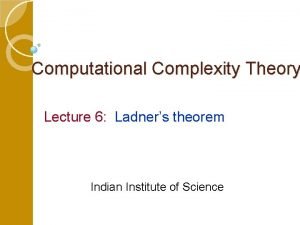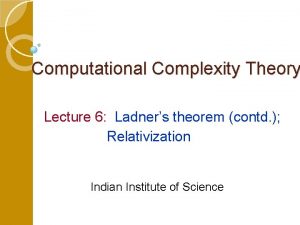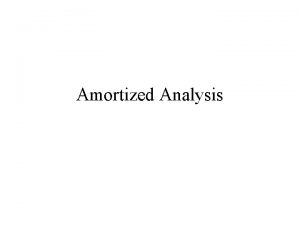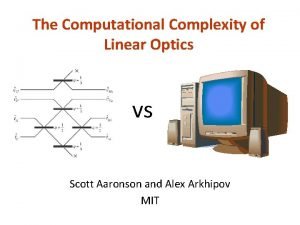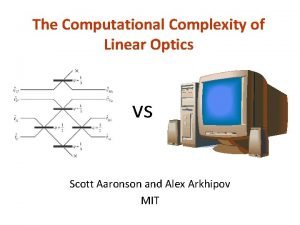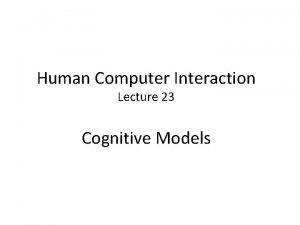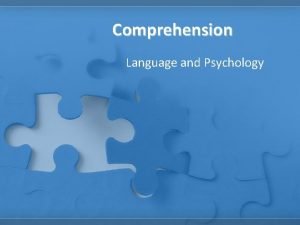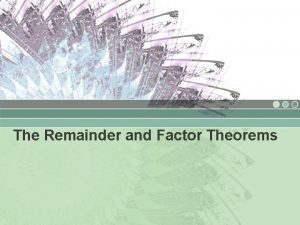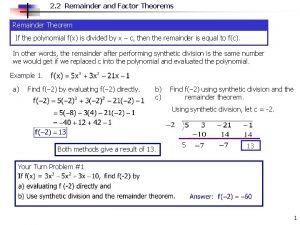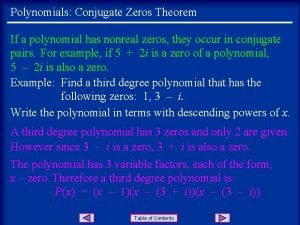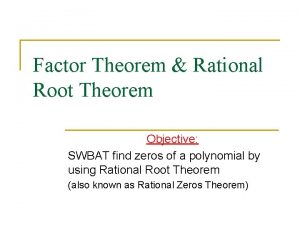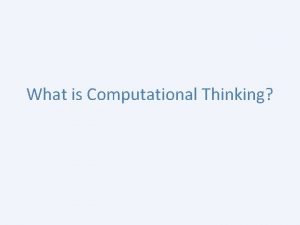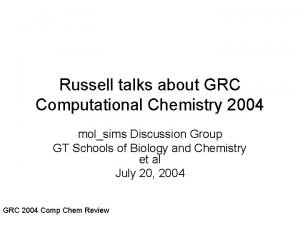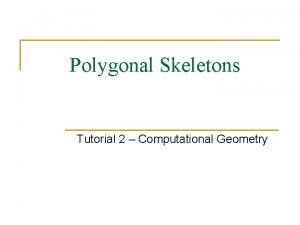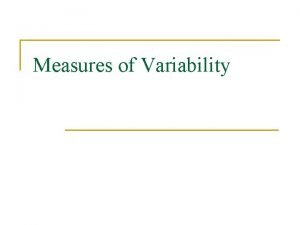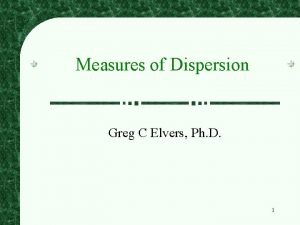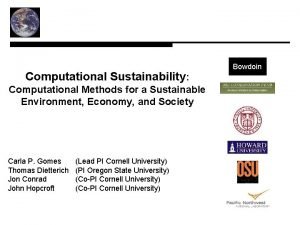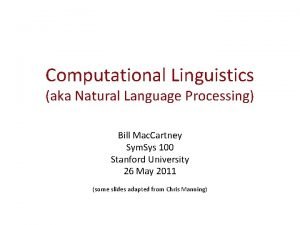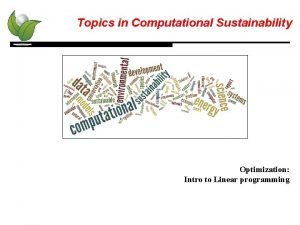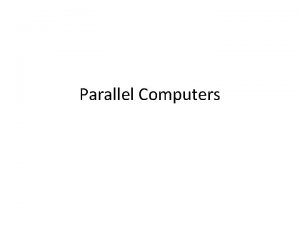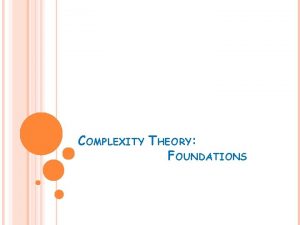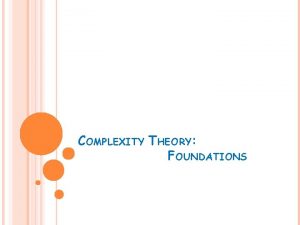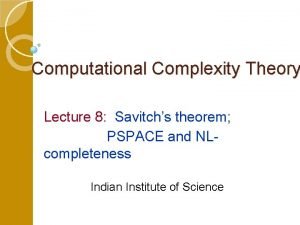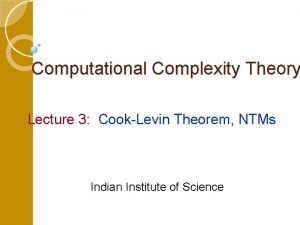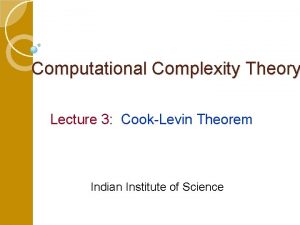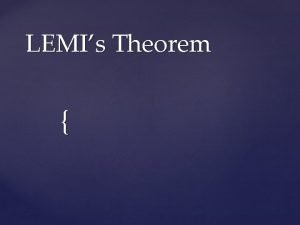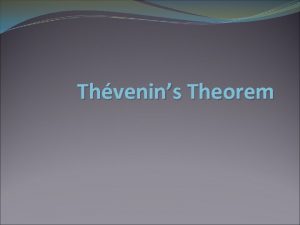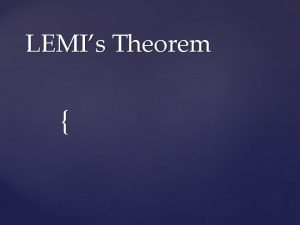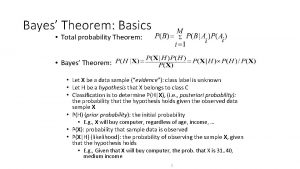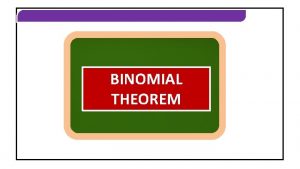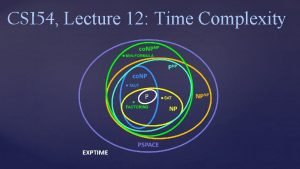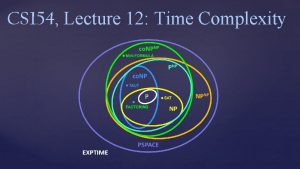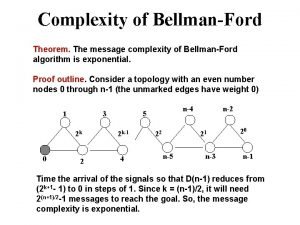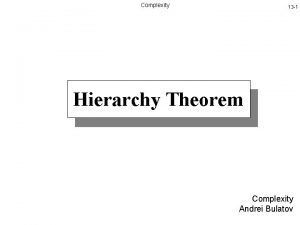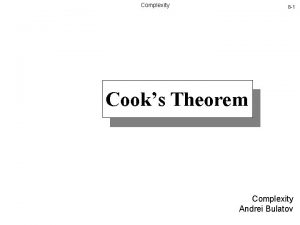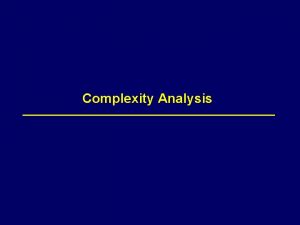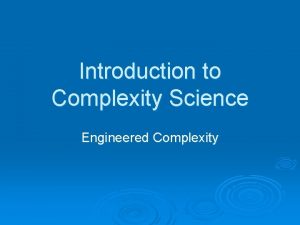Computational Complexity Theory Lecture 6 Ladners theorem contd








































- Slides: 40

Computational Complexity Theory Lecture 6: Ladner’s theorem (contd. ); Relativization Indian Institute of Science

Recap: Class co-NP and EXP �Definition. A language L ⊆ {0, 1}* is in co-NP if there’s a poly-time TM M and a poly function p such that x∈L u∀ ∈{0, 1}p(|x|) s. t. M(x, u) = 1 �Definition. c EXP ≥ 1 EXP = c ∪ DTIME ( 2 n ) NP co-NP P

Recap: Diagonalization �Diagonalization refers to a class of techniques used in complexity theory to separate complexity classes. �These techniques are characterized by two main features: 1. There’s a universal TM U that when given strings α and x, simulates Mα on x with only a small overhead. 2. Every string represents some TM, and every TM can be represented by infinitely many strings.

Recap: Time Hierarchy Theorem �Let f(n) and g(n) be time-constructible functions s. t. , f(n). log f(n) = o(g(n)). �Theorem. DTIME(f(n)) ⊊ DTIME(g(n)) P ⊊ EXP

Recap: Ladner’s theorem �Definition. A language L in NP is NPintermediate if L is neither in P nor NP-complete. �Theorem. (Ladner) If P ≠ NP then there is an NPintermediate language. Proof. Let H: N N be a function. Let m. H(m) SATH = {Ψ 0 1 : Ψ ∈ SAT and |Ψ| = m} H would be defined in such a way that SATH is NPintermediate (assuming P ≠ NP )

Recap: Properties of H �Theorem. There’s a function H: N N such that 1. H(m) is computable from m in O(m 3) time 2. SATH ∈ P H(m) ≤ C (a constant) 3. If SATH ∉ P then H(m) ∞ with m

Recap: Proof of Ladner’s theorem P ≠ NP �Suppose SATH ∈ P. Then H(m) ≤ C. �This implies a poly-time algorithm for SAT as follows: Ø On input ϕ , find m = |ϕ|. m. H(m) Ø Compute H(m), H(m) and construct the string ϕ 0 1 m Ø Check if ϕ 0 1 belongs to SATH length at most m + 1 + m. C

Recap: Proof of Ladner’s theorem P ≠ NP �Suppose SATH is NP-complete. Then H(m) ∞ with m. �This also implies a poly-time algorithm for SAT: f SAT ≤p SATH ϕ Ψ 0 1 k Ø On input ϕ, compute f(ϕ) = Ψ 0 1 k. Let m = |Ψ|. Ø Compute H(m) and check if k = m. H(m). Ø W. l. o. g. nc = |f(ϕ)| ≥ m 2 c √n ≥ m

Recap: Proof of Ladner’s theorem P ≠ NP �Suppose SATH is NP-complete. Then H(m) ∞ with m. �This also implies a poly-time algorithm for SAT: f SAT ≤p SATH ϕ Ψ 0 1 k Ø On input ϕ, compute f(ϕ) = Ψ 0 1 k. Let m = |Ψ|. Ø Compute H(m) and check if k = m. H(m). Ø W. l. o. g. nc = |f(ϕ)| ≥ m 2 c Thus, checking if an n-size √n ≥ m formula ϕ is satisfiable reduces to checking if a √n-size formula Ψ is satisfiable.

Construction of H �Observation. The value of H(m) determines membership in SATH of strings whose length is ≥ m. �Therefore, it is OK to define H(m) based on strings in SATH whose length is < m (say, log m).

Construction of H �Observation. The value of H(m) determines membership in SATH of strings whose length is ≥ m. �Therefore, it is OK to define H(m) based on strings in SATH whose length is < m (say, log m). �Construction. H(m) is the smallest k < log m s. t. 1. Mk decides membership of all length up to log m strings x in SATH within k. |x|k time.

Construction of H �Observation. The value of H(m) determines membership in SATH of strings whose length is ≥ m. �Therefore, it is OK to define H(m) based on strings in SATH whose length is < m (say, log m). �Homework. Prove that H(m) is computable from m in O(m 3) time.

Construction of H �Claim. If SATH ∈ P then H(m) ≤ C (a constant). �Proof. There is a poly-time M that decides membership of every x in SATH within c. |x|c time.

Construction of H �Claim. If SATH ∈ P then H(m) ≤ C (a constant). �Proof. There is a poly-time M that decides membership of every x in SATH within c. |x|c time. �As M can be represented by infinitely many strings, there’s anα ≥ c s. t. M = Mα decides membership of every x in SATH within α. |x|α time. �So, for every m satisfying α < log m, H(m) ≤ α.

Construction of H �Claim. If H(m) ≤ C (a constant) then SATH ∈ P. �Proof. There’s a k ≤ C s. t. H(m) = k for infinitely many m.

Construction of H �Claim. If H(m) ≤ C (a constant) then SATH ∈ P. �Proof. There’s a k ≤ C s. t. H(m) = k for infinitely many m. �Pick any x ∈ {0, 1}*. Think of a large enough m s. t. |x| ≤ log m and H(m) = k.

Construction of H �Claim. If H(m) ≤ C (a constant) then SATH ∈ P. �Proof. There’s a k ≤ C s. t. H(m) = k for infinitely many m. �Pick any x ∈ {0, 1}*. Think of a large enough m s. t. |x| ≤ log m and H(m) = k. �This means x is correctly decided by Mk in k. |x|k time. So, Mk is a poly-time machine deciding SATH.

Natural NP-intermediate problem? �Integer factoring. FACT = {(N, U): there’s a prime ≤ U dividing N} �Claim. �So, NP. FACT ∈ NP ∩ co-NP FACT is NP-complete if and only if NP = co-

Natural NP-intermediate problem? �Integer factoring. FACT = {(N, U): there’s a prime ≤ U dividing N} �Claim. FACT ∈ NP ∩ co-NP �Proof. FACT ∈ NP : Give p as a certificate. The verifier checks if p is prime (AKS test), p ≤ U and p divides N.

Natural NP-intermediate problem? �Integer factoring. FACT = {(N, U): there’s a prime ≤ U dividing N} �Claim. FACT ∈ NP ∩ co-NP �Proof. FACT ∈ NP : Give complete prime factorization of N as a certificate. The verifier checks if none of the prime factors is ≤ U.

Natural NP-intermediate problem? �Integer factoring. FACT = {(N, U): there’s a prime ≤ U dividing N} �Factoring algorithm. Dixon’s randomized algorithm factors an n-bit number in exp(O(√n log n)) time.

Power & limits of diagonalization �Like in the proof of P ≠ EXP, can we use diagonalization to show P ≠ NP ? �The answer is No, if one insists on using only the two features of diagonalization.

Oracle Turing Machines �Like in the proof of P ≠ EXP, can we use diagonalization to show P ≠ NP ? �The answer is No, if one insists on using only the two features of diagonalization. �Definition: Let L ⊆ {0, 1}* be a language. An oracle TM ML is a TM with a special query tape and three special states qquery, qyes and qno such that

Oracle Turing Machines �Like in the proof of P ≠ EXP, can we use diagonalization to show P ≠ NP ? �The answer is No, if one insists on using only the two features of diagonalization. �Definition: Let L ⊆ {0, 1}* be a language. An oracle TM ML is a TM with a special query tape and three special states qquery, qyes and qno such that whenever the machine enters the qquery state, it immediately transits to qyes or qno depending on whether the string in the query tape belongs to L. (ML has oracle access to L)

Oracle Turing Machines �Like in the proof of P ≠ EXP, can we use diagonalization to show P ≠ NP ? �The answer is No, if one insists on using only the two features of diagonalization. �Think of physical realization of ML as a device with access to a subroutine that decides L. We don’t count the time taken by the subroutine. query Decider for L ML

Oracle Turing Machines �Like in the proof of P ≠ EXP, can we use diagonalization to show P ≠ NP ? �The answer is No, if one insists on using only the two features of diagonalization. �Think of physical realization of ML as a device with access to a subroutine that decides L. We don’t count the time taken by the subroutine. �The transition table of ML doesn’t have any rule of the kind (qquery, b) (q, c, L/R).

Oracle Turing Machines �Like in the proof of P ≠ EXP, can we use diagonalization to show P ≠ NP ? �The answer is No, if one insists on using only the two features of diagonalization. �Think of physical realization of ML as a device with access to a subroutine that decides L. We don’t count the time taken by the subroutine. �We can define a nondeterministic Oracle TM similarly.

Oracle Turing Machines �Like in the proof of P ≠ EXP, can we use diagonalization to show P ≠ NP ? �The answer is No, if one insists on using only the two features of diagonalization. �Important note: Oracle TMs (deterministic/nondeterministic) have the same two features used in diagonalization: For any fixed L ⊆ {0, 1} *, 1. There’s an efficient universal TM with oracle access to L, 2. Every ML has infinitely many representations.

Relativization

Complexity classes using oracles �Like in the proof of P ≠ EXP, can we use diagonalization to show P ≠ NP ? �The answer is No, if one insists on using only the two features of diagonalization. �Definition: Let L ⊆ {0, 1}* be a language. Complexity classes PL, NPL and EXPL are defined just as P, NP and EXP respectively, but with TMs replaced by oracle TMs with oracle access to L in the definitions of P, NP and EXP respectively.

Complexity classes using oracles �Like in the proof of P ≠ EXP, can we use diagonalization to show P ≠ NP ? �The answer is No, if one insists on using only the two features of diagonalization. �Definition: Let L ⊆ {0, 1}* be a language. Complexity classes PL, NPL and EXPL are defined just as P, NP and EXP respectively, but with TMs replaced by oracle TMs with oracle access to L in the definitions of P, NP and EXP respectively. SAT ∈ PSAT

Relativizing results �Like in the proof of P ≠ EXP, can we use diagonalization to show P ≠ NP ? �The answer is No, if one insists on using only the two features of diagonalization. �Observation: Let L ⊆ {0, 1}* be an arbitrarily fixed language. Owing to the ‘Important note’, the proof of P ≠ EXP can be easily adapted to prove PL ≠ EXPL by working with TMs with oracle access to L. �We say that the P ≠ EXP result relativizes.

Relativizing results �Like in the proof of P ≠ EXP, can we use diagonalization to show P ≠ NP ? �The answer is No, if one insists on using only the two features of diagonalization. �Observation: Let L ⊆ {0, 1}* be an arbitrarily fixed language. Owing to the ‘Important note’, any proof/result that uses only the two features of diagonalization relativizes.

Relativizing results �Like in the proof of P ≠ EXP, can we use diagonalization to show P ≠ NP ? �The answer is No, if one insists on using only the two features of diagonalization. �Is is true that - either PL = NPL for every L ⊆ {0, 1}* , - or PL ≠ NPL for every L ⊆ {0, 1}*? Theorem (Baker-Gill-Solovay): The answer is No. Any proof of P = NP or P ≠ NP must not relativize.

Relativizing results �Like in the proof of P ≠ EXP, can we use diagonalization to show P ≠ NP ? �The answer is No, if one insists on using only the two features of diagonalization. �Is is true that - either PL = NPL for every L ⊆ {0, 1}* , - or PL ≠ NPL for every L ⊆ {0, 1}*? Theorem (Baker-Gill-Solovay): The answer is No. Any proof of P = NP or P ≠ NP must not relativize.

Baker-Gill-Solovay theorem �Theorem: There exist languages A and B such that PA = NPA but PB ≠ NPB. �Proof: Using diagonalization!

Baker-Gill-Solovay theorem �Theorem: There exist languages A and B such that PA = NPA but PB ≠ NPB. �Proof: Let A = {(M, x, 1 m): M accepts x in 2 m steps}. �A is an EXP-complete language under poly-time Karp reduction. �Then, PA = EXP. �Also, NPA = EXP. Hence PA = NPA.

Baker-Gill-Solovay theorem �Theorem: There exist languages A and B such that PA = NPA but PB ≠ NPB. �Proof: Let A = {(M, x, 1 m): M accepts x in 2 m steps}. �A is an EXP-complete language under poly-time Karp reduction. �Then, PA = EXP. A. �Also, NPA = EXP. Hence PA = NP A Why isn’t EXP = EXP ?

Baker-Gill-Solovay theorem �Theorem: There exist languages A and B such that PA = NPA but PB ≠ NPB. � Proof: For any language B let LB = {1 n : there’s a string of length in B}. �Observe, LB ∈ NPB for any B. (Guess the string, check if it has length n, and ask oracle B to verify membership. )

Baker-Gill-Solovay theorem �Theorem: There exist languages A and B such that PA = NPA but PB ≠ NPB. � Proof: For any language B let LB = {1 n : there’s a string of length in B}. �Observe, LB ∈ NPB for any B. �We’ll construct B (using diagonalization) in such a way that LB ∉ PB, implying PB ≠ NPB.
 Ladners theorem
Ladners theorem Baker gill solovay
Baker gill solovay Address contd
Address contd Amortized complexity examples
Amortized complexity examples The computational complexity of linear optics
The computational complexity of linear optics The computational complexity of linear optics
The computational complexity of linear optics For loop space complexity
For loop space complexity Stokes theorem
Stokes theorem 01:640:244 lecture notes - lecture 15: plat, idah, farad
01:640:244 lecture notes - lecture 15: plat, idah, farad Cognitive complexity theory in hci examples
Cognitive complexity theory in hci examples Bathtub effect in psycholinguistics
Bathtub effect in psycholinguistics Complexity theory
Complexity theory What is bnf in hci
What is bnf in hci Natural language processing
Natural language processing Decision theory lecture notes
Decision theory lecture notes Sargur srihari
Sargur srihari Natural language processing lecture notes
Natural language processing lecture notes The remainder theorem
The remainder theorem Factor theorem
Factor theorem Factor theorem and remainder theorem
Factor theorem and remainder theorem Conjugate zeroes theorem
Conjugate zeroes theorem Rational root theorem and factor theorem
Rational root theorem and factor theorem Linear factors theorem and conjugate zeros theorem
Linear factors theorem and conjugate zeros theorem Characteristics of computational thinking
Characteristics of computational thinking Computational thinking algorithms and programming
Computational thinking algorithms and programming Grc computational chemistry
Grc computational chemistry Using mathematics and computational thinking
Using mathematics and computational thinking Computational geometry tutorial
Computational geometry tutorial Usc neuroscience major
Usc neuroscience major Standard deviation computational formula
Standard deviation computational formula What is dispersion in statistics
What is dispersion in statistics Computational math
Computational math Computational thinking gcse
Computational thinking gcse Computational sustainability cornell
Computational sustainability cornell Chomsky computational linguistics
Chomsky computational linguistics Xkcd computational linguistics
Xkcd computational linguistics Carnegie mellon computational biology
Carnegie mellon computational biology Dsp computational building blocks
Dsp computational building blocks Computational sustainability subjects
Computational sustainability subjects Leerlijn computational thinking
Leerlijn computational thinking Computational speed
Computational speed
